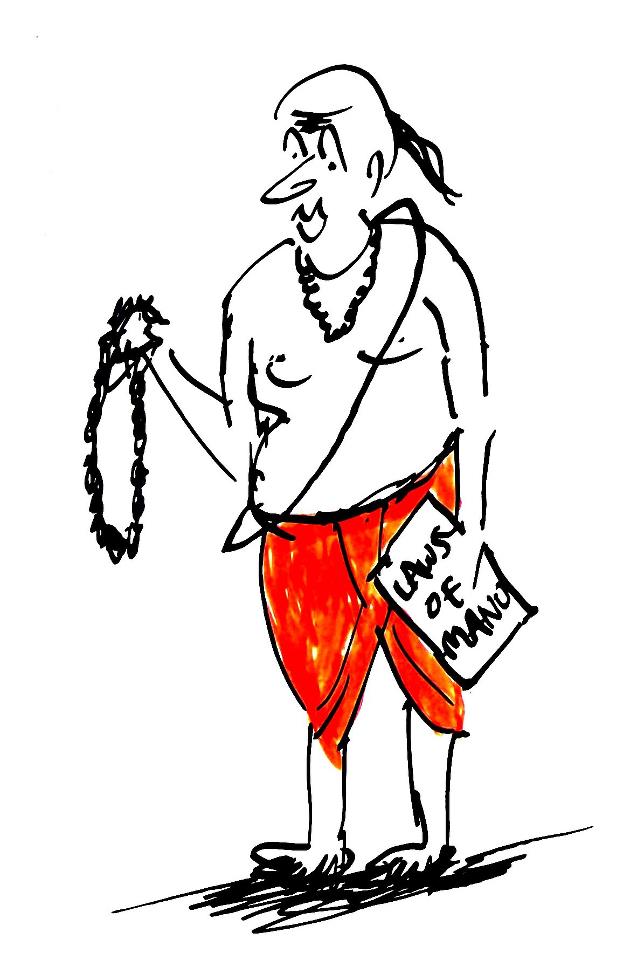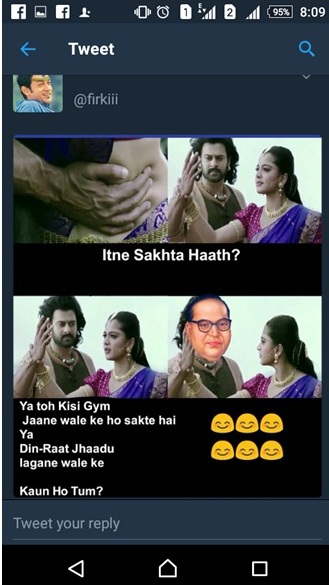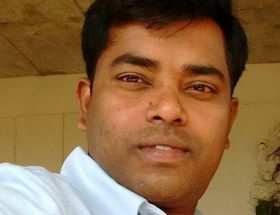Karthik Navayan

Society in India
A society should be a humane society; the pre-requisite of a society is that the groups of people constituting it should be related to each other through persistent relations. But in Indian society, people are not only unrelated to each other but also hate each other, and the castes belonging to the lower strata are not even left with the freedom that certain animals enjoy. The caste system in India denies human status to its fellow beings and treats them worse than animals. We can see that some animals like cows, pigs are given godly status whereas the so-called untouchables are denied entry not only into temples but also denied the right to even walk on the common paths. The saga especially of the downtrodden castes and the women belonging to these castes is highly deplorable. But still we call Indian society a ‘society’?
In Hindu ‘society’, caste is the most powerful instrument in determining a person’s dignity. Caste system is the result of the Hindu belief of ‘Reincarnation and Karma’. The four castes eventually developed into a social mosaic of 3000 sub-castes, with the Untouchables at the bottom of the list; in real sense they are out of the list. Such a rigid caste system is not found anywhere in the world except in India. If a person is born into a caste, his status is predetermined and immutable. Birth decides one’s status and this cannot be altered by the talent developed by the individual or by the wealth the person may accumulate. Similarly, the caste in which a person is born predetermines what vocation the person will pursue. One has no choice. Birth decides the occupation of the person. This caste system discriminates between human persons and stratifies them into different groups. Manu Dharma[1], the Hindu religious code of conduct, divides human persons into four Varnas[2].
The Hindu Indian society has defined a particular code of conduct to persons belonging to every caste. It also sanctified how a person or persons belonging to a particular caste shall relate themselves to a person or group of persons belonging to upper castes and lower castes with reference to this own caste. These were the four original varnas:
1. Brahmins (the Priestly Class)
2. Kshatriyas (the Warrior Class)
3. Vaishyas (the Trading Class)
4. Shudras (the Servants)
Situation of women
The Manu Dharma Shastra denied equal status to women, on par with men, and imposed restrictions on her: “Her father protects (her) in childhood, her husband protects (her) in Youth, and her sons protect (her) in old age; a woman is never fit for independence.”[3]
A woman has no right to study, let alone the Vedas. Women cannot utter the Veda Mantras, as they are unclean[4]. A Brahman, Kshatriya, or Vaisya man can sexually exploit any Shudra woman[5]. Even the act of killing a woman is explicitly justified as a minor offence for the Brahmins; equal to the killing of an animal.
Any society has to fulfill certain basic necessary conditions if it is to survive. These basics are known as functional pre-requisites of a society. Sociologists differ in their views regarding the identification of the functional pre-requisites. Some sociologists view social stratification as a fundamental pre-requisite, while some others view reproduction and socialisation as the functional pre-requisites of society.
With regards to the stratification of Indian society, Dr Ambedkar says “Caste is not just a division of labour, it is a division of labourers”; he also says:
“It is a pity that Caste even today has its defenders. The defenses are many. It is defended on the ground that the Caste System is but another name for division of labour; and if division of labour is a necessary feature of every civilized society, then it is argued that there is nothing wrong in the Caste System. Now the first thing that is to be urged against this view is that the Caste System is not merely a division of labour. It is also a division of laborers. Civilized society undoubtedly needs division of labour. But in no civilized society is division of labour accompanied by this unnatural division of laborers into watertight compartments. In addition, the Caste System is is a hierarchy in which the divisions of laborers are graded one above the other. In no other country is the division of labour accompanied by this gradation of laborers[6].
The Caste System is in itself a degenerate form of the Chaturvarnya which is the ideal of the Hindu. How can anybody who is not a congenital idiot accept Chaturvarnya as the ideal form of society? Individually and socially it is a folly and a crime. One class and one class alone to be entitled to education and learning! One class and one class alone to be entitled to Arms! One class and one class alone to trade! One class and one class alone to serve! For the individual the consequences are obvious. Where can you find a learned man who has no means of livelihood who will not degrade his education? Where can you find a soldier with no education and culture who will use his arms to conserve and not to destroy? Where can you find a merchant with nothing but the acquisitive instinct to follow who will not descend to the level of the brute? Where can you find the servant who is not to acquire education, who is not to own Arms, and who is not to possess other means of livelihood, to be a man as his Maker intended him to be?”[7]
From the above observations of Dr Ambedkar it is clear that calling Indian society a society is somewhat problematic and those who claim and declare themselves as civil society in India in the name of fighting against corruption are actually ideologically corrupt and those who are gathered around them, speaking against the reservations to the Scheduled Castes and Scheduled Tribes show that they are not civil in nature. The Indian Hindu society primarily lacks the pre-requisites of a society because of the caste system.
Caste is gaining strength day after day. The traditional caste is disappearing and its modern forms are emerging. And the modern casteism is more dangerous, more influential and invisible. Even the movements started with the goal of working against the caste system are becoming part of the caste system. Some organizations of the so-called lower castes which initially worked against the caste system are now actually strengthening the caste system, as Bhagwan Das observes: “Dalit parties have worked to strengthen the caste system, by further driving a wedge between scheduled castes and other groups. Their method of assertion is wrong. Only a few people in the corridors of power have benefited from the ascendancy of some Dalit leaders. For example, a Chamar leader will only work for his community since Dalits as a whole are not united.'[8]
The living experience of caste differs from not only caste to caste but also from person to person. The living experience of caste of the so called lower caste is different from the living experience of caste of the so called upper caste. And how the so called upper caste describes “how caste operates” is different from how the so called lower caste would describe it.
If we check the caste back ground of 1) Child Labourers 2) Beggars 3) Prostitutes 4) Street Children 5) Rag pickers… and other victims of tragedies like communal riots, natural disasters in India, we’ll find that most of worst victims are from the so-called untouchable castes.
Law in India
Caste was the law in India for centuries. Caste as an ideology of hierarchy that most Indians believe and practice in their day to day life is the decisive factor in Indian life, and is the root cause of the denial of human dignity and of gross violation of human rights. It is important to see the plight of implementation of equality legislations of India.
Law in India, or the system of laws in modern India, is largely based on the English common law because of the British Rule, which justified the caste system. Much of contemporary Indian law shows substantial European and American influence. Various legislations first introduced by the British are still in effect in modified forms today. They were framed according to the guidance and suggestions of Hindu Brahmanical brokers.
Indian family law is complicated, with each religion adhering to its own specific laws. In most states, registering of marriages and divorces is not compulsory. Separate laws govern Hindus, Muslims, Christians, Sikhs, but there is no Buddhist marriage act as the Brahmanical Hindus claimed that Buddhism is part of Hinduism. Actually, “Hinduism and Buddhism are distinct religions and cultures. They are different in many ways that define who they are and what their faith is. Hinduism was not founded by any sort of prophet, whereas Buddhism was founded by the Buddha. Hindus believe in the Vedas, but Buddhists do not believe in the Vedas or any other Hindu holy book; they do not believe in the existence of souls, or God.”[9]
The exception to this rule is in the state of Goa, where a Portuguese uniform civil code is in place. There are about 1221 laws in India. However, since there are Central laws as well as State laws, and it’s difficult to ascertain their exact numbers.
The speech by Dr Ambedkar in the Indian constitution Assembly gives a complete picture of “Indian Society”. He says:
‘We must begin by acknowledging first that there is complete absence of two things in Indian society. One of these is equality. On the social plane, we have in India a society based on privilege of graded inequality which means elevation of some and degradation for others. On the economic plane we have a society in which there are some who have immense wealth as against the many who are living in abject poverty. On the 26th January 1950, we are going to enter into a life of contradictions. In politics we will have equality. In politics we will be recognizing the principle of one man and one vote and one vote one value. In our social and economic structure, continue to deny the principle of one man one value.'[10]
Dr Balagopal, a human rights activist, mathematician and lawyer from Andhra Pradesh, said:
“Law is not what the legislature made; the law is what the court says legislature made, and that is a very important distinction. Even a law maker, who is an MLA or MP, cannot say I made a different law, he is not allowed to say, once the court says this is the law you made. That is the law, and the Legislature will have to amend the law if they feel this is not the law they made; this instance happened recently when seven judges of the supreme court of India declared it is unconstitutional to direct the private sector colleges to give reservations. The judgment is unconstitutional, but had the constitution makers been here today they would simply have to amend the constitution, they can’t do anything. They have amended the constitution now, totally unnecessary amendment caused by the unconstitutional judgment”
This observation of Dr Balagopal clears the confusion. Even though there are good legislations, it is impossible to implement them until and unless the judiciary and executive also believe in them. Actually there is no reservation in higher judiciary and all high courts and supreme courts were/are filled by Hindu upper caste judges who believe in and practice caste. The Hindu ideology which is the root cause of inequality and discrimination is the guiding principle for most of them. Installing Manu’s Statue in the Rajasthan High court is a small example of the judges’ mindset in India.
Another news reported in the Times of India says “Several members in the Lok Sabha on Tuesday demanded action against a judge of the Allahabad High Court, who as part of ”purifying” his chamber, earlier occupied by a judge belonging to the Scheduled Caste, allegedly cleaned it with Ganga water. Labour minister Sathyanarayana Jatiya assured the House that the government would ascertain facts and take ”appropriate action.’ These are our judges.
Not only judges, many people in India including members of the so-called civil society, the politicians, religious heads, social activists, academics, and the lawyers merely speak against the practice of untouchability, but support the existing caste system; in the minds of Hindus it is a sin if they do not practice untouchability. They believe that caste was given by god. The Hindus, including judges and bureaucrats and other officials believe and practice what’s written in their religious mythological texts, the Ramayana and Mahabharata, Vedas and Manusmriti– the literature which justifies the mischievousness, rapes, cheating, insulting, killing, burning of people of the untouchable, or so-called lower castes.
The problem of untouchability, discrimination and atrocities on the so-called untouchable castes originated from the caste system which treated them as secondary human beings. And the colonial construction of caste provided rulers’ position to the Indian Hindu upper castes and legitimized their higher status as normal. That led the whole Indian democratic system to become a caste prejudiced system that always favours the perpetrators of the atrocities on Scheduled Castes and Scheduled Tribes in the name of culture and tradition. And it created an impossible situation for the implementation of Scheduled Castes and Scheduled Tribes (Prevention of Atrocities) Act 1989.
This attitude is in tune with the culture and mythology of Hindu religion which celebrates festivals after someone’s killing: Dussehra is celebrated after the killing of the king Mahishasura by Goddess Durga, and Deepavali is celebrated after the killing of Narakasura, another king, by goddess Bhudevi. In modern times also, many atrocities on the so-called lower caste people and groups- involving killing, raping and burning them- are reported on or during Hindu festivals.
To be continued.
~~
References
[1] Which legitimizes the untouchability, denial of freedom, self respect, right to education, property to the dalits and women
[2] Varna means color, the Caste
[3] Manusmriti IX.3
[4] Manusmriti IX.18
[5] Manusmriti IX.25
[6] http://ccnmtl.columbia.edu/projects/mmt/ambedkar/web/section_4.html
[8] Das Bhagwan, Times of India, April 15, 2005 – http://articles.timesofindia.indiatimes.com/2009-04-15/interviews/28041839_1_dalit-politics-caste-system-indian-politics
[9] Laxmaiah Mallepally, The Hans India, 10th May, 2012.
[10] Dr Ambedkar’s address to the Constitution Assembly, 25th November (1949), (Constitution Assembly Speech, vol.2 at 184-187).
[11] Dr Balagopal’s speech on Caste and Law in EFL-University, organized by Department of Cultural Studies available at http://www.archive.org/details/BalagopalOnHumanRightsMovementInIndia
[12] The Times of India/New Delhi/22 July, 1998.
~~~
Karthik Navayan is a human rights activist.
Illustration by Unnamati Syama Sundar.










